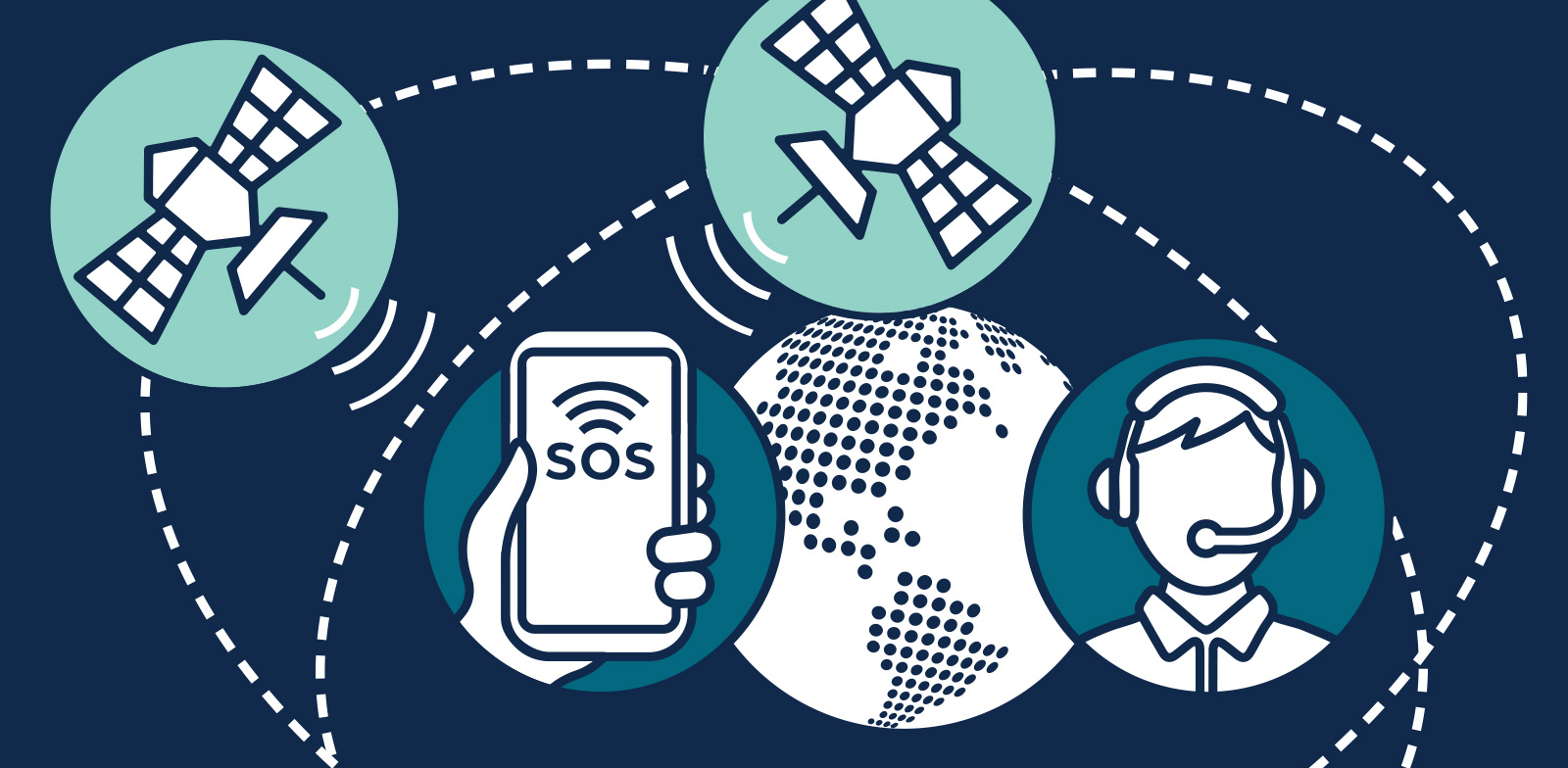Satellite Solutions for Emergency Communications
What’s Your Plan for 911 Services? As satellite communications gain significant momentum, companies are aggressively planning how emergency services...
Breakthrough technologies seem to come at us in bursts of innovation, and recent industry announcements are no exception. Apple introduced their iPhone 14 with an Emergency SOS via satellite feature, “enabling messaging with emergency services when outside of cellular or Wi-Fi coverage,” in the USA and Canada. T-Mobile and SpaceX announced “Coverage Above and Beyond: a breakthrough new plan to bring cell phone connectivity everywhere” via satellite. And in Asia, Huawei announced their Mate 50 mobile phone which reportedly can send messages through China’s global satellite network.
If there’s one thing that we can count on in public safety, it’s that the gears of change will never stop turning. Landline to mobile. 4G to 5G/IoT. And now the much-anticipated low earth orbit (LEO) communications. Using satellites to send for help could be a game changer, especially knowing how much our public safety community has struggled with network dead zones that isolate both the injured mountain climber and the first responder desperately trying to render aid in harsh environments.
So, will space become the final frontier in public safety or just another way that we find and communicate with those who need help? Time will tell, but while some of these new services may take months to troubleshoot and optimize, others will be offered just weeks after their announcement. As such, Intrado has been planning and developing solutions in anticipation of their impact on public safety and emergency response workflows in North America and wherever these global innovations will reach. As we evaluate any new technology, the goal must remain the same: for first responders to continue to respond as quickly and as accurately as possible.
As we evaluate any new technology, the goal must remain the same: for first responders to continue to respond as quickly and as accurately as possible
What problem will satellite communications solve? Communication service providers work to provide readily available, life-enhancing services, within regulatory constraints, and with finite resources. As with any enterprise, they must abide by their economic realities, which has meant to date that diverse terrains make it hard to reach everyone cost-effectively. You can put a cell tower on a backcountry trail, but that tower must connect somehow to the network—most likely either some expensive fiber optic cable or point-to-point microwave backhaul devices that require a clear line of sight. That presented some significant network design challenges with 3G and 4G cellular technologies.
But those same network operators also continued to invest—and more and more, partner, as in the case of T-Mobile and SpaceX—in developing new generations of technology. 5G networks will be served by greater network densification with numerous, smaller transmission points, placed everywhere from street lampposts to school rooftops, but not everyone lives in dense urban environments.
With that context in mind, just how game-changing will a low-earth orbit solution be for public safety? Given that most of these new offers will only offer text messaging to start, they won’t be as impactful as sensors, video, and other IoT-driven incident data in significantly improving the user experience. But, for anyone in trouble staring down at a smartphone with no signal bars, or for a first responder fighting to save a community where the communications network was wiped out by a natural disaster, any connection at all—any user experience at all—changes the game on that day.
Where do we start? As always, with location. To borrow a phrase from the hotel industry, the three most important things in emergency response are location, location, and location. As data works across our processes and systems end-to-end, we need location to properly manage the call routing and handling, we need location as we process the incident (especially if the caller is on the move), and we need location as we tranche that information out to dispatch.
All these new satellite-based offers require a way to find those who can’t otherwise be found. If our goal is to respond as quickly and as accurately as possible, then any new technology solution must be able to ascertain location quickly and accurately enough that the telecommunicator can dispatch resources in that first minute of receiving a request for assistance—be it a voice call, text, or some other machine-to-machine communication. Just making the call won’t save someone’s life, as the technologists envision, if we can’t find them.
Before we can act on that, we will need to determine how we are going to route these satellite RFAs (Requests for Assistance) to the proper jurisdiction – potentially anywhere in the world. The accuracy from the satellite side is not perfect, and the cell tower location won’t help as we’ve taken the tower out of the picture in this scenario. Fortunately, we’ve already started to bridge the network uncertainties when it comes to location and routing. In developing Locate Before Route with AT&T, our innovation teams at Intrado were able to leverage device-based hybrid (DBH) data, in conjunction with dynamic routing (including PIDF-LO, an i3 protocol that delivers a location reference in the initial call), to provide more accurate mobile handset location and thus reduce time-wasting call transfers. We started to drive location and routing beyond the towers to the mobile device itself.
Improving location accuracy saves time and increases the level of trust in acting on that information. Emergency communications centers will want to know that the accuracy of a text message will be the same as a voice call. The telecommunicators will want to know the class of service (how network traffic is managed) of the source of the data, whether the RFA is coming from a wireless phone or a VoIP phone or a satellite transmission, and the assumed level of location certainty associated with those services.
Location anchors the RFA through all the systems and touchpoints in play, as well as curates the handoffs across all the public safety organizations involved in an incident.
How would we add such a capability to the workflow? Well, we wouldn’t want to add it, actually. You want to integrate such a feature into your optimized workflow seamlessly. The last thing we would want to see is another screen in the emergency call center for some new Satellite-RFA application. As such, public safety agencies may not want to invest straightaway in every new technology idea that comes along—the hardest part of technology management is choosing which capabilities to add and when. We want to consider, instead, a more rational, disciplined (as they say) approach to investing in new technology introduction into your workflows.
The biggest challenge for the public safety community might be to figure out how to take advantage of such innovation without getting caught up in the entire commercialization process, or what the industry pundits have dubbed a space race. First responders likely want to stay focused on the job at hand today, with one eye on the stuff that can make jobs easier (if that’s such a thing) down the road. This kind of change often doesn’t come easy. We spent a lot of time on this blog talking about cloud migration, for example. It is as much about what you want to do with the technology as the technology itself.
I think this is where the concept of partnership bubbles up into the conversation. It’s a term that gets thrown around a lot, especially by technology vendors such as we are, but at some point, the complexity of the infrastructure and the rate of innovation grows to where it becomes really challenging to master by any one person or organization. The difference between vendors and partners seems to be in whom you trust over the long haul. Working together to solve complex problems in a way that is straightforward and most transparent to the user brings out the best in all of us.
An opportunity to appreciate standards and regulations. Yeah, I said that out loud. I recognize that reading all those FCC rules and i3 documentation can be a bit cumbersome, but those efforts are what organize what otherwise might be chaos. Standards are what make new technologies work together across vendors and help to get innovation into the field more quickly and with less risk. It will help push us, for example, to make sure that we figure out how to identify the Z-axis location associated with a satellite-based RFA, to where we know whether that injured mountain climber is trapped on the cliff face or stuck in a ravine.
We all want these cool innovations to be adopted as soon as possible. That’s especially true in the life-and-death environment in which we operate. But the reality is that these new ideas take time to come to life in a way in which we can make use of them safely and reliably. SpaceX has their work cut out for them to design new rockets to carry massive new antennas, while they do the genius math to connect our mobile phones with hunks of metal screaming across space. The device manufacturers will need their customers to upgrade to the latest generation of smartphone in order to take advantage of the new service. That gives us the time to figure out not how we are going to adopt this new technology but to adapt it to our needs in public safety. There is a difference. We don’t want to just adopt the hype; we want to adapt a new capability to best help us help others.
We don’t want to just adopt the hype; we want to adapt a new capability to best help us help others
And as our innovation teams track the emergence of the Metaverse, quantum communications, and the Internet of Everything, it’s likely that space won’t end up being the final frontier for public safety. With each new technology we adapt and integrate, we can anticipate some head-scratching challenges but also meaningful rewards. But we have to stay focused on what problem we are trying to solve, or we risk introducing technology for technology’s sake.
If you’re interested in reading more about solving the challenge of emergency communications over satellite connectivity, download our whitepaper.

What’s Your Plan for 911 Services? As satellite communications gain significant momentum, companies are aggressively planning how emergency services...

For years we’ve all repeated the mantra that technology is evolving quickly in the world of emergency communications. That technology...

Data is incredibly valuable to Public Safety Answering Points (PSAPs). Another critical component is time. Data and time may be the two most vital...

To be prepared for emergencies, schools should review their mass notification systems and...